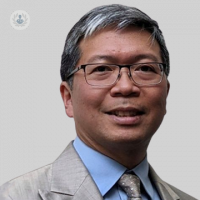Why would I need an endobronchial ultrasound (EBUS)?
Written by:An endobronchial ultrasound (EBUS) is a highly effective diagnostic procedure with many different applications that has become widely used in the UK.
Here to provide an expert insight into the EBUS procedure, how is it performed, how EBUS differs from a bronchoscope and its side effects, is consultant respiratory physician, Dr Tuck-Kay Loke.

What is an EBUS?
An EBUS is a minimally invasive diagnostic procedure that has been used by lung cancer specialists for the past 20 years.
During the procedure, the bronchoscope, with a small ultrasonic probe at its tip, is passed through the mouth into the airways. With the ultrasound, the operator is then able to visualise the tumour and the lymph nodes on a screen – structures that a standard bronchoscope are not able to easily access.
The EBUS procedure has enhanced the diagnostic capacity of lung specialists, helping shorten the time of diagnosis of lung cancer patients as well.
What is the difference between a bronchoscope and an EBUS?
A bronchoscope is a traditional fibre optic endoscope that is usually passed through the nose or the mouth and into the airways. The tool has an optical camera at the tip of the scope, from which images are projected onto a screen.
An EBUS is similar to a bronchoscope, but in addition to the fibre optic camera, an EBUS also contains an ultrasonic probe at the tip. The probe allows the imaging of the ultrasound to be projected at the same time as the fibre optic images.
What is an EBUS used to diagnose?
An EBUS is a very versatile tool that can be used for:
- lung disorders
- primarily haematological conditions
- lymphoma
- tuberculosis
- sarcoidosis
- conditions that cause enlargement of the mediastinal lymph nodes and the higher lymph nodes
However, from the perspective of a pulmonary physician, an EBUS is often used for the diagnosis and staging of lung cancers. This is because the lymph nodes in the mediastinum (the central structures of the thoracic cavity) cannot be easily accessed by any other means.
With an EBUS scope, ultrasonic images can be projected onto a screen. These images can then be used, in real time, to guide the operator during a transbronchial needle aspiration (TBNA), which is a procedure that samples the lymph nodes using a small needle. The cells obtained during the TBNA can be studied later on under a microscope to clarify a lung cancer diagnosis.
How is an EBUS performed?
An EBUS is generally performed under conscious sedation, meaning that the patient is given short-acting medication through an intravenous cannula. The medication used for sedation is a fast-acting drug that can, in some cases, cause the patient to fall asleep for up to half an hour. Patients may often wake up after EBUS, with little recollection of the procedure itself.
After sedation, a local anaesthetic is then applied to the throat and to the mouth to numb these areas (where the scope will pass through).
In experienced hands, the EBUS procedure takes between 15 to 20 minutes to complete.
Is the EBUS procedure painful?
No, an EBUS is not painful. This is because opiates or morphine-based drugs are used in the procedure, in addition to local anaesthetic and sedation.
Patients may experience an unusual sensation when the scope is being passed down the back of their mouth and into their throat, but apart from that, an EBUS is not painful or necessarily unpleasant. In general, patients go home on the same day of the procedure.
How long does it take to get results from an EBUS?
The time for processing TBNA samples can vary from department to department.
At Maidstone and Tunbridge Wells NHS Trust (MTW), the samples are sent straight after the EBUS to the pathology lab. The Pathology Department generally takes about five working days to provide a report.
The results from the EBUS are typically discussed five to seven days following the procedure itself at the local multidisciplinary meeting of specialists.
Dr Tuck-Kay Loke is a consultant respiratory physician with more than 25 years of clinical experience working in the National Health Service, United Kingdom.
If you need to undergo an EBUS and would like to know more about the procedure, do not hesitate to book a clinic appointment with Dr Loke today.



